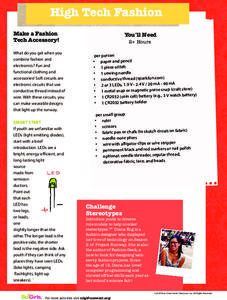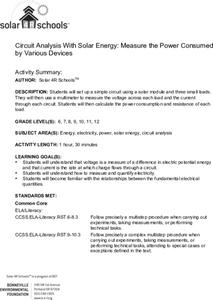Bonneville
What is Electricity and How Do We Use It?
Use some electrifying lessons to learn about electricity. Future scientists discover the history of electricity and the basics of electric circuits. They learn how to read an electricity bill and then create circuits to power a fan,...
PBS
Locker Lights
Light up a locker for a more festive hallway! Scholars learn about electric currents, LEDs, and switches, then experiment with their own circuits. They use the circuits to design and build locker decorations that light up when turned on...
PBS
Keep Out!
Sound the alarm about a great resource. Scholars first build a simple circuit to learn the basics about electric currents. They then design an alarm system in which a buzzer activates when pressure is applied to a doormat.
PBS
High Tech Fashion
Creatively combine clothes and conductors. Pupils learn how to use conductive thread to make electric circuits. They apply the thread to design and build an accessory item with LEDs.
PBS
Dough Creatures
Knead a resource on electric circuits? A fun activity teaches future scientists about conductors and insulators. They prepare conducting and insulating dough and use them to make creatures that light up.
Bonneville
Macro-Scale Solar
There's no substitute for the power of the sun. The second of four installments of the Solar Resources Assessment unit looks at macro-scale photovoltaic (PV) technology. Future scientists first learn about PV modules with a PowerPoint...
Bonneville
Simple Solar Tracker
Let the solar cells fight each other for supremacy! Given a functional solar tracker that moves toward light, groups copy the design to build their own devices. They use two sets of solar cells that have reverse polarization, so that the...
Bonneville
Solar Tracker Challenge
Follow the light—not with one's eyes—but with a special solar tracker. Future engineers design and build a device that tracks light. They must build circuits in which solar cells rotate to receive equal amounts of light.
Bonneville
Circuit Analysis With Solar Energy: Measure the Power Consumed by Various Devices
Power up the class with a lesson on electronics. Scholars use a solar module to create an electric circuit. They connect different devices to the circuit and measure the voltage and current. Based on the measurements, they calculate the...
Bonneville
Designing a Solar Phone Charger
What a bright idea! Working in groups, scholars design a solar phone charger by applying concepts from the unit. They use solar modules and buck and boost converters in their creations, which must be able to charge a phone after...
Bonneville
DC to AC to DC Efficiency
The power to learn about AC and DC power lies within everyone. The fifth of seven installments in the Off the Grid unit continues the investigation of the efficiency of a USB charger. Individuals use an inverter that converts DC power to...
Bonneville
Exploring Buck and Boost Converters
Boost one's knowledge of converters. The fourth of seven installments in the Off the Grid unit looks at buck and boost converters, which lower and raise the input voltage. Scholars apply the converters to adjust the output voltage to...
Bonneville
Phone Charger Efficiency
Be efficient in learning about efficiency. A fun hands-on activity has pupils calculate the efficiency of cell phone chargers by measuring the power in and power out. They also learn how to read and use circuit diagrams.
Bonneville
Activities and Assessment of Vocabulary and Units
It's pass or fail, and one must pass to move on to the next lesson plan—no pressure. The second of seven installments in the Off the Grid unit has pupils demonstrate their knowledge of vocabulary as well as the process of using a...
Bonneville
Solar Panel Basics
Going outside is a logical step when dealing with solar panels. Future scientists learn about the n-type and p-type layers of solar cells in the third of 14 lessons in the Cost Effective Solar Cells unit. They go outside to model the...
Bonneville
Engaging with Solar Panels
Build a fan and become a fan of solar power. The second of 14 lessons in the Cost Effective Solar Cells unit has learners first construct circuits with solar cells to power a fan, a motor, and an LED. They then test their circuits both...
Bonneville
Introduction to Circuits
Light up the class's knowledge. Pupils build a simple circuit using a battery, wire, and a light bulb and create a diagram of their circuit. The teacher provides a short lecture on a complete circuit, calling attention to the direction...
Museum of Science
City Circuit
Here's an electric lesson on electricity. Pupils create an electric circuit to model a city's electric system. They then test out different materials to see whether they are conductors of electricity.
Museum of Science
Circuit Board
Light up the solutions. By following a set of directions, pupils build a circuit board with six different circuits. Learners use the circuit board to create a matching activity by connecting the questions to the correct answers via a...
Teach Engineering
Consult for the Conductive Circuit Card Company
Light up someone's day with conductive greeting cards. Scholars design and create greeting cards that include LED lights. Rather than use copper tape, they apply conductive paint or copper paint to create the necessary electric circuits.
Teach Engineering
Powering a Device Using Food
Eat up a resource on using food to power electrical devices. Future engineers first experiment with different fruits and vegetables to determine the amount of electrical energy they provide. Based on the data, they design and create an...
NASA
Providing Light for Your Plants
Using a guided lesson, pupils learn about what it takes to make a circuit along with a switch. They build a complete circuit under the direction from the teacher and identify each of the elements of the circuit. Scholars then learn to...
Science Friday
Make a Speaker
Make science come in loud and clear. Pupils learn about how a speaker works by building one. The scholars first learn about electromagnetic fields by building an electromagnet. Using that knowledge, they build a crude speaker using a...
Science Matters
Parallel Circuits
The lights don't always go out when the switch is flipped. The 10th lesson plan in a series of 14 helps learners build a conceptual understanding of the flow of electricity through a parallel circuit. They then build their own parallel...
























